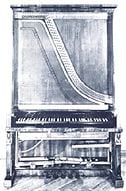Piano with Automatic Accompaniment System in Beethoven's Day

Modern pianos usually have three pedals. Among them is one called the damper pedal that functions to sustain the sound, and another called the una corda pedal that softens the sound.
However, in Beethoven's day, when pianos were a symbol of "high technology," many pianos were built that had four or more pedals. In Vienna, pianos built by a man named Georg Haschka were known for their multiple pedals, among which was an instrument with eight pedals. The purpose of the pedals of this era was to change the tone and timbre of the notes like the stops of an organ. A classic example of this is the so-called "Turkish" or "Janissary" (Janitscharen) pedal that, when pressed with the foot, played cymbals, bells, and drums in synchrony with the keyboard in imitation of the sound of a Turkish military marching band. This could be called a 19th-century version of the piano with automatic accompaniment system which we can experience on Diskvier pianos today.
(Reference: "Ongaku Kikai Gekijo" ("Music Machine Theatre"), by Hiroshi Watanabe, 1997; published by Shinsho-kan)
Musical Instrument Guide : Piano Contents
Origins
Structure
How to Play
How the Instrument is Made
Choosing an Instrument
Care and Maintenance
Trivia
- The White Keys and Black Keys Were Reversed on Pianos in Mozart's Day
- Did Mozart's Piano Have a Pedal-Board?
- Piano with Automatic Accompaniment System in Beethoven's Day
- The Pianos Beloved by the Great Master, Sviatoslav Richter
- The Optimal Material for Piano Frames Is Also Ideal for Motorcycle Engines
- The Piano Soundboard Is a Board that Also Stops Vibrations
- Why Can't There Be More Than 88 Keys on a Piano?
- Why a Grand Piano Keyboard Feels Heavier Than an Upright Keyboard?
